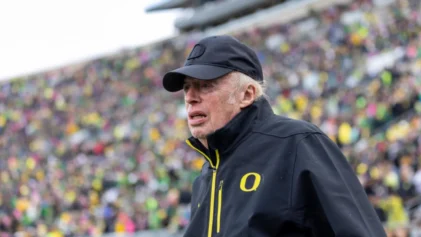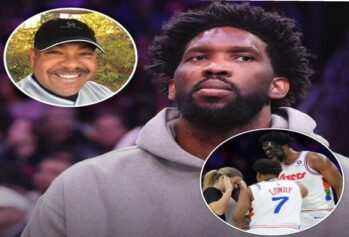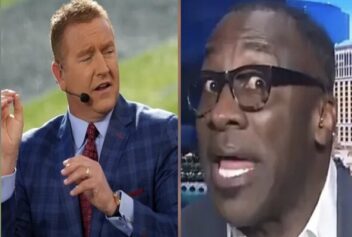In a significant shift for college sports, the NCAA’s top governing body said it supports a rule change allowing student-athletes to profit from their name, image and likeness, so long as the college or university they attend does not pay them directly.
The plan includes players receiving compensation from social media and personal appearances, as well as through businesses they started.
This was widely reported as a blow to the NCAA’s billion dollar free labor network it has thrived off of. As well as the governing body’s suffocating lock on a student athlete’s ability to profit off of their success in a free market.
Prior to that bombshell being dropped, baller Dashien Nix decommitted from UCLA, becoming the third ESPN Top 100 player to spurn the one-and-done rule for immediate financial gain in the G League Pathway Program, making upwards of $500,000 plus endorsements.
https://twitter.com/_cxyoung/status/1063314529541636097
The Shadow League’s hoops insider Champ Guru cautions that this turn of events doesn’t hurt the NCAA. In fact, it puts college basketball in an even better position to compete for the top players with the NBA and the G League.
CHAMP GURU (@championshipuniversity):
The NBA has to sit down and rethink this thing because the G League becomes somewhat obsolete to many of the top players now.
If I’m the No. 1 player in the nation going to college for one year is way better than going to the G League. If I have the opportunity to go to the G League or the best hoops program in the country, and everyone knows who I am already, then I’m going to college. I’m getting the best of both worlds.
I’m getting a newly expanded fanbase. I own my likeness. I’m going to make money. I’m playing with my peers and I’m learning to play with a shot clock. I’m on the big stage, March Madness…I think it’s more of an advantage playing for a Power School (Michigan, UNC, Duke) and making money than playing for the G League with no fans.
The NBA, NCAA, and G League are like three interlocking bodies who work together but are also in competition to corner the market on big time, profit-generating basketball talent.
The Beginning
The O’Bannon Brothers played and starred on UCLA’s 1995 NCAA title squad. In 2009, Ed O’Bannon and 19 others sued the NCAA, claiming the organization violated United States antitrust laws by not allowing athletes to get a share of the profits generated from the use of their images in broadcasts and video games.
O’Bannon was able to get the NCAA to shut down EA Sports Football and Basketball because it was using players’ likeness and not paying them.
From a public standpoint, that really got the engine going and heightened the conversation we’ve been having for the past decade about paying college players and student-athlete exploitation by the NCAA.
Before the lawsuit, you had the straight out of high school rule that was in place for players who didn’t want to go to college and were gifted enough to play in the NBA. Kobe Bryant and Kevin Garnett were beneficiaries of that. But then the NBA came back with the one-and-done rule, to prohibit these kids from getting right to the bag and ensuring that they make some money for the colleges for at least one year.
So to combat that, you had guys like Brandon Jennings electing to go overseas for one year, but overall, the NCAA still ruled with an iron fist, refusing to adapt to the changing landscape in American sports.
Genius Of Lavar Ball
When Lavar Ball, Mr. Chino Hills himself and Lonzo Ball went the nontraditional route and created their own Big Baller sneaker brand rather than get in bed with the big time shoe companies like Adidas, Under Armor and Nike — and Zo still went No. 2 overall in the Draft, that shifted perceptions even more.
Then he removed his younger kids (DiAngelo and Melo) from school and took them overseas to play basketball. Then he started his own JBL league where he wanted to pay guys $10,000 a month. Everybody in the media, including George Raveling, said: “he’s the worst thing to happen to college basketball in 100 years.”
You had news media outlets that were egging him on but also trying to make a mockery of him saying it was all about Lavar and not his kids.
Fast Forward to 2020.
19-year-old Melo Ball is a projected Top 5 NBA Draft pick and already a celebrity. He and his manager were in negotiations to purchase the NBL team that he played for (Illawarra Hawks).
Then the G League countered that with paying top high school prospects north of $300,000 to play basketball. They also provide training and allow the players to sign endorsement deals.
One Year Of College Trumps G League Big Brand Players
Then the NCAA makes this ruling and everybody thinks it’s game over for the NCAA. On the contrary.
Allowing players to be compensated enables the NCAA to counter the G League’s bank with a bigger power play, because the NCAA has one thing the G League doesn’t have; attraction… a fan base… a body of students and alumni, people who are going to get behind you. So if you can own your likeness and you can profit off that at any time of the day, whether it be modeling, or doing commercials for a local business or major companies like American Express, Pepsi, Kellog or Capital One — you name it — it’s a win-win.
Now, you have the college machine behind you and you can get paid off of what you bring to the table.
Players Who Would Have Secured The Bag Under The New Rule
This is, of course, specifically for the big time universities and Top 100 players, The McDonald’s All-American’s and Jordan Brand players.
Christian Laettner
Can you imagine if Christain Laettner owned his likeness attending Dukes for four years, winning championships, and having the impact on college hoops that he had?
He would’ve come out of Duke a millionaire, easily.
Fab Five
Can you imagine the Fab Five owning their likeness? Those guys would have been multi-millionaires before they played in the NBA. And the supporting players like Ray Jackson and Jimmy King weren’t the stars Webber, Howard, and Rose was.
The Fab Five was a brand that brought incredible attention and money to the university. Jimmy and Ray never got paid the big time dollars in the NBA, but they were integral parts of the Fab Five brand. They should have left college millionaires. They generated that much and more for the school during their time there.
https://youtu.be/01lUanofdLg
Larry Johnson & UNLV Runnin Rebels
Look at Tarkanian’s Runnin’ Rebels of UNLV. Imagine if Larry Johnson and those guys could do commercials and personal endorsement deals in college?
Popularity equals money and those guys were as popular as it gets. The entire starting five would have been millionaires.
Steph Curry
Imagine Steph Curry, coming out of nowhere, playing three years of his exciting style of ball at Davidson, and owning his likeness. Every kid is coming to the game with a Curry jersey or hat or signature shoe — whatever he’s promoting, and he’s making a percentage of that.
https://youtu.be/4tyS7l2Gy3s
Cassius Winston
Winston is the one guy that stands out the most in terms of… he probably won’t be an NBA All-star but he’s a hell of a basketball player whose popularity and fan support probably peaked in college. That’s also when he was most dominant and marketable, especially to the college community and businesses.
The businesses and community groups in the modest towns where some athletes grew up, would also benefit from hiring local success stories to push their product.
I’m willing to put all the coins on the table that Winston’s jersey would have sold out at Michigan State every home game especially after he became a star in his junior and senior seasons.
CHESS: Next Move For NBA
So, I think if that is the case I think the NCAA is above the G League as far as opportunity for star players and the NBA will have to make a counter move and lift the high school rule and allow kids to come straight to the League. They’re also going to have to change the rookie contract because a top prospect like Jalen Green probably can make more money in college basketball now as a freshman than a rookie in the NBA if he profits off his brand correctly.
Let’s say Zion Williamson signs with Nike out of high school and can have his own signature shoe — AND still play at Duke — then what is the purpose of running to the NBA right away?
You can take online classes, get your degree, make millions of dollars, and go to college and create this huge marketing brand for yourself before going to the NBA.



